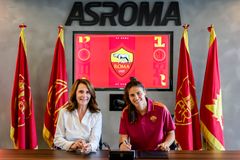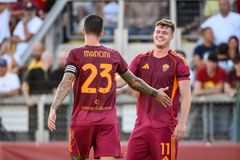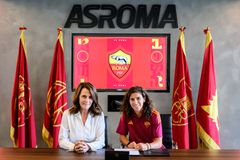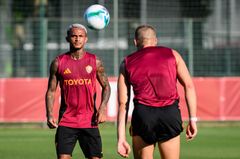
“I always put the running in and gave everything I had when I was on the field, perhaps because I played with joy,” he explained in an interview with Roma Radio years after his time with the club.
It’s been nearly 35 years since Cerezo’s last appearance in a Roma jersey, yet the Giallorossi fans still nurture fond memories of the Brazilian – not least because of his namecheck in the Italian film Vacanze di Natale ('Christmas Holidays').
And watching his performances back now – or perhaps even seeing them for the first time – helps us to understand the impact he had on Italian football.
Cerezo was an extraordinary, complete footballer. A modern footballer. Occupying the “volante” position (the term used in South America to denote a midfielder that sits in front of the defence), he was a very different type of player to many of his peers.
He had the vision to build the play – a base requirement for that position – but he also boasted impressive physical and technical attributes which made him a danger when getting forward. It’s no coincidence that, in 104 competitive appearances for Roma, he scored 25 goals and was often moved up the pitch to play in a more attacking role.
When Cerezo bore down on the penalty box, few defenders were capable of preventing him from getting a shot away. Before his arrival in Rome, the local fans had got a taste of his ability in Italy's unforgettable 3-2 win over Brazil at the World Cup in 1982 in Spain.
The match saw Cerezo come close to scoring after bursting forward with one of his trademark runs, only to be thwarted by Dino Zoff as Italy won the game on their way to World Cup glory.
Extra attacker
Strength and speed were two of Cerezo’s main weapons – two that he drew on regularly. Roma’s 3-0 win over IFK Goteborg on 14 September 1983 was an historic one for the Giallorossi in that it was the club’s first ever appearance in the European Cup.
Yet it is also remembered for Cerezo scoring one of the greatest goals in Roma history. Cerezo had already gone close to getting his name on the scoresheet after catching the Swedish defence unprepared following a ball from Agostino Di Bartolomei…
What followed minutes later was an unforgettable exhibition of creativity and skill, as Cerezo linked up beautifully with fellow Brazilian Paulo Roberto Falcao to score Roma’s third goal.
The final seconds of the move must be watched closely. Bruno Conti starts off the move from the left, before spying Cerezo unmarked and finding him with his back to goal. The Brazilian has already looked to see where his team-mates are positioned and decides to let the ball run for the unmarked Falcao rather than controlling and slowing the ball down.
Then, Cerezo turns tail and bursts towards the area as the move continues.
Falcao’s talent – his genius – is there for all to see in his contribution to the move, despite the fact that he never actually makes contact with the ball. First, he lets the ball run through to Francesco Vincenzi, who controls and then plays the ball back towards Falcao, now around ten yards outside of the penalty box.
Yet Falcao opts to dummy again, allowing the fast-approaching Cerezo to collect it. There appears to be no way for Falcao to actually see Cerezo arriving – but he just knows his team-mate is going to be there to profit from his unusual assist.
A quick look at Goteborg’s right-sided centre-back speaks volumes about the effectiveness of that series of dummies and feints. He looks almost disorientated as he struggles to read how the move is going to develop – and that split-second spent deciding whether to stay with Falcao or switch to Cerezo is all the latter needs to pounce.
He controls with his right, then beats the keeper at his near post with a deft shot.
Football. And joy.
There were dummies and first-time touches in other fine Cerezo goal worthy of a mention here. And though this one was less important, coming against Bari in the Coppa Italia on 4 September 1985, it was still nothing short of spectacular.
The goal features a truly sumptuous sequence of passes. Conti – out on the right this time – passes the ball infield.
Manuel Gerolin lets the ball run through his legs to Zbigniew Boniek, who plays a first-time pass forward to Cerezo, who has drifted into space behind the two Bari central midfielders. On the edge of the box, Cerezo backheels the ball to Sandro Tovalieri, who returns the favour by completing the one-two.
The pass provides Cerezo with the chance to shoot with his left foot – the Brazilian obliges, finding the net at the near post.
San Siro was the setting for one of Cerezo’s best ever goals, which the Brazilian scored at the end of an individual move which showcased his extraordinary technical ability. The goal came in a 2-1 defeat to AC Milan on 14 October 1984, the game that saw Di Bartolomei and Nils Liedholm face off as opponents for the first time. Midway through the second half, Cerezo decided to do this:
Keep your eye on the ball: it seems glued to Cerezo’s feet during the entire move, from the initial feint to the way he deftly slips through the narrowest of gaps between two Rossoneri defenders to get into the box and beat the outrushing Giuliano Terraneo.
The long-range effort and the headers
Anyone who had the good fortune of watching Cerezo in the flesh and living through his time at Roma will have fond memories of some of the spectacular goals he scored for the club.
One of his most memorable long-range goals was scored against Hellas Verona in the first leg of the 1983-94 Coppa Italia final on 21 June 1984.
Cerezo was also known for his headers: goals that he could score thanks to his physical strength but also his opportunism.
Seven of Cerezo’s 25 goals for Roma were scored with his head, including his first league goal for the club, in the 5-1 win over Napoli on 30 October 1983.
He also scored a header in Roma’s victory in the Coppa Italia final second leg against Sampdoria on 14 June 1986 – his final appearance for the Giallorossi before joining the Blucerchiati.
A central cog for both Liedholm and Eriksson
It would be over-simplistic to remember Cerezo’s time at Roma through his goals and assists alone. In his first season in Italy, in 1983-84, Cerezo’s understanding with Falcao and Di Bartolomei – despite some initial teething problems – was at the heart of the Giallorossi’s deep run to the European Cup final.
It meant coach Nils Liedholm had a trio of top players in their prime of their careers in the middle of the park – players adept in all phases of the game who could link up with one another constantly.
Di Bartolomei was the man who started off the moves – but could drop back into central defence when required.
Falcao and Cerezo, meanwhile, were the creative hub of the team and had licence to move freely when the Giallorossi were in possession, allowing them to provide width, attempt to lose their markers and open up spaces.
Cerezo in particular had the freedom to roam between midfield and attack, drifting into half-spaces and looking to play off central striker Roberto Pruzzo. At times the Brazilian would get forward into space, like a proper No.9, while at others his job was to get into the box to support Pruzzo.
It was a role that resulted in Cerezo scoring plenty of goals – 14 in his first season alone, to be precise.
Under Sven-Goran Eriksson, who took over for the 1984-85 season, Roma continued to play a zonal game but changed their style of play. The Giallorossi left the calm control and technical quality typical of Liedholm’s so-called “spider’s web” style behind in favour of a more direct approach and more constant pressing.
Despite sustaining a couple of injuries that forced him to miss a number of games, Cerezo adapted well to the higher tempo and quickly built a good understanding with his new team-mates: Di Bartolemei had joined AC Milan in the summer, while injuries kept Falcao out for most of the season, meaning Cerezo often lined up alongside Carlo Ancelotti and Giuseppe Giannini.
Eriksson’s Roma were at their best in the 1985-86 season, when the arrival of Boniek and the resurgence of Pruzzo saw them put their struggles in front of goal behind them (in the previous season the team managed just 33 goals in 30 games, with only 24 of the goals coming from open play).
The team came close to winning the Scudetto that year. On their day, they were able to dominate their opponents by playing at an intensity that was rarely seen in the mid-1980s.
It was a season of memorable results, such as the 3-0 win over Juventus on 16 March 1986.
“My Roma was a very good team. We always played to win and dictate the play. I was lucky to be a part of it,” said Cerezo when he was inducted into the AS Roma Hall of Fame.
Cerezo’s movement, his ambling running style and a pair of legs that looked even longer on account of his rolled-down socks are unmistakable to this day. There was joy in his positive approach to the game.
Cerezo was able to build a connection with the fans and create a joyful atmosphere around the team – he sent the Roma fans into raptures with moments of spectacular skill, yet at the same time was always ready to put the hard yards in for his team-mates.
In the Roma history books, there will always be a special place for this moustachioed Brazilian with his infectious smile.
Toninho Cerezo represented AS Roma between 1983 and 1986.
In total he played 104 games for the club, scoring 25 goals from central midfield.
He was a part of the Coppa Italia-winning sides of 1984 and 1986, while he also started the 1984 European Cup final. With Brazil, he played in both the 1978 and 1982 World Cups.

 Tickets
Tickets
 Shop
Shop





































